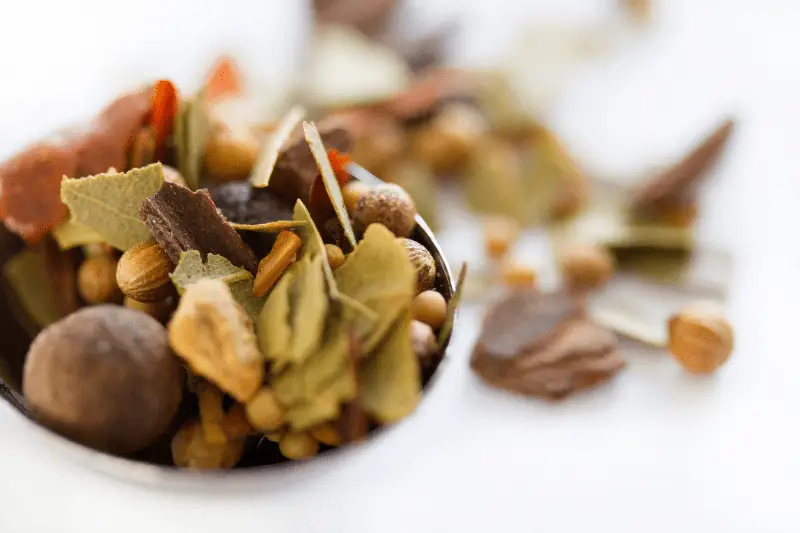Pickling is a time-honored technique that has been used for centuries to preserve fruits and vegetables.
It involves immersing the produce in a vinegar brine, which creates an acidic environment that inhibits the growth of bacteria, thus extending the shelf life of the food.
But the pickling process isn’t just about preservation; it’s also about adding flavor to the preserved produce, and that’s where pickling spices come in.
 Pickling Spice to Use Per Pint” class=”wp-image-2357″/>
Pickling Spice to Use Per Pint” class=”wp-image-2357″/>How Much Pickling Spice to Use Per Pint?
In general, it’s recommended to use about 1 to 2 teaspoons of pickling spice per pint of vinegar brine.
This amount serves as a great starting point, but don’t be afraid to adjust the quantity based on your personal taste preferences.
If you prefer a milder flavor, start with 1 teaspoon per pint, and for those who enjoy a more robust taste, feel free to increase the amount to 2 teaspoons or even more.
Just remember, it’s always easier to add more spice later on, but you can’t take it out once it’s mixed into the brine.
The Role of Pickling Spice
Pickling spice is a blend of various herbs and spices that’s added to the vinegar brine to give the pickled produce its distinctive flavor. The exact blend of spices used can vary depending on the recipe and personal taste preferences, but there are some common ingredients found in most pickling spice blends.
Key Ingredients in Pickling Spice
Mustard Seeds
Mustard seeds are a common ingredient in pickling spice blends, providing a pungent, slightly bitter flavor that’s essential in many pickled recipes.
Allspice
Allspice is a versatile spice that provides a warm, sweet, and slightly peppery flavor to pickling spice blends.
Coriander Seeds
Coriander seeds bring a bright, citrusy, and slightly sweet flavor to pickling spice blends.
Cloves
Cloves are a potent spice that contributes a warm, sweet, and slightly bitter flavor to pickling spice blends.
Peppercorns
Peppercorns add a bold, spicy, and slightly fruity flavor to pickling spice blends, with black, white, and green peppercorns all being popular choices.
Red Pepper Flakes
Red pepper flakes are often included in pickling spice blends for those who enjoy a bit of heat in their pickled goods.
Bay Leaves
Bay leaves contribute a subtle, earthy, and slightly bitter flavor to pickling spice blends.
Determining the Right Amount of Pickling Spice
When it comes to determining how much pickling spice to use per pint, a general guideline is to use about 1 to 2 teaspoons of pickling spice per pint of vinegar brine. This is a good starting point, but keep in mind that personal taste preferences will ultimately dictate the ideal amount of spice for your pickling project.
Adjusting for Taste
Feel free to adjust the amount of pickling spice used based on your personal preferences. If you prefer a milder flavor, use closer to 1 teaspoon per pint. For a more robust, spicier flavor, increase the amount to 2 teaspoons or even more. Remember that it’s always better to start with less and add more if needed, as you can’t remove the spice once it’s in the brine.
Making Your Own Pickling Spice Blend
One great way to ensure you’re using the perfect amount of pickling spice for your taste is by making your own blend. This allows you to customize the flavors and control the spice levels. Experiment with different combinations of spices and herbs until you find the perfect mix for your pickling projects.
Pickling Tips and Tricks
Choose fresh, high-quality fruits and vegetables for pickling. Look for produce that is free of blemishes and is firm to the touch. The fresher the produce, the better the final product will be.
Sterilizing Your Jars
Proper sterilization of your jars is essential for successful pickling. Wash the jars, lids, and bands in hot, soapy water and rinse well. Then, place the jars in a large pot of boiling water for 10 minutes to sterilize them. Remove the jars using a jar lifter and place them on a clean towel to dry.
Processing Times
Processing times for pickled goods can vary depending on the type of produce being pickled and the desired level of crunchiness. Generally, processing times range from 10 to 30 minutes in a boiling water bath. Be sure to follow a trusted recipe and adjust processing times for your altitude if necessary.
Conclusion
In conclusion, the amount of pickling spice used per pint of vinegar brine can range from 1 to 2 teaspoons, depending on personal taste preferences. By adjusting the amount of pickling spice and experimenting with your own spice blends, you can create delicious, perfectly flavored pickled goods that suit your tastes. Don’t forget to follow best practices for pickling to ensure a successful, tasty final product.
Frequently Asked Questions
- Can I use store-bought pickling spice?
Yes, store-bought pickling spice is a convenient option for those who don’t want to make their own blend. Just be sure to check the ingredients list to ensure it meets your taste preferences.
- Do I need to use pickling salt?
Pickling salt is recommended because it is free of additives and anti-caking agents that can cloud your brine. However, if you don’t have pickling salt, you can substitute non-iodized, additive-free kosher salt or sea salt.
- Can I reuse my pickling brine?
It’s generally not recommended to reuse pickling brine, as its acidity and flavor profile may have been altered during the initial pickling process. It’s best to make a fresh batch of brine for each pickling project.
- How long do I need to wait before eating my pickled goods?
While some pickled items can be enjoyed after just a few days, most pickled goods should be allowed to sit for at least 2 to 4 weeks to develop their full flavor.
- How long will my pickled goods last?
Properly canned and stored pickled goods can last for up to a year or more. Once opened, they should be stored in the refrigerator and consumed within a few months for the best quality.
